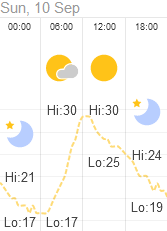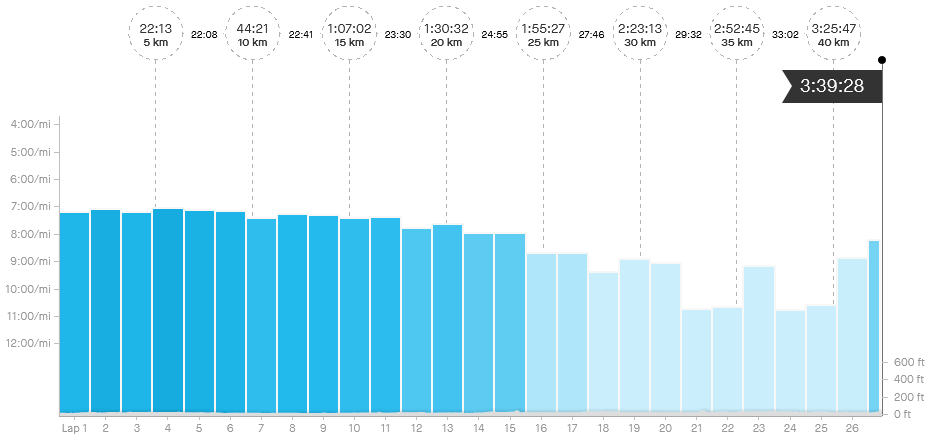Training
For this race I had wanted to follow the Pfitzinger 12/70 marathon plan or at least the 17/50 variant, but I was having a problem with a tightness in my groin muscles causing severe discomfort a week prior to the scheduled 17 weeks. After a week of testing the waters with the discomfort I decided to rest up a few more weeks and pursue the shorter 12 week long 12/55 plan, just like last year and perhaps add a few miles here and there in the circumstance that I was feeling fresh enough (that time never came).
Training was similar to that of last year. I had completed The Kew Half Marathon a few weeks previously to starting with a new PR of 01:27:50 which boosted confidence, and I was running faster and longer than I ever had. Sub 7 minute miles seemed like moderate runs now, as opposed to near max effort, which is something I thought I would never be capable of.
Training was interrupted for 3 weeks by our yearly holiday to Italy. Weekly mileage dipped to the low 20s due to lack of time and because the hot weather over there made it impossible to log any long distance efforts, especially at speed. After coming home, I attempted to see where my fitness was with a 10k time trial which yielded some excellent results in the form of a PR (38:47). Then a week before the actual race during the penultimate "Recovery & Strides" session, I managed to injure my left ankle.
After carefully trotting on it for the remaining week, I felt confident enough to turn up to the start line of the Richmond Marathon 2023. My peak mileage had been 57 miles, and the longest run I did was 18 miles. I felt like I was definitely undertrained, but would try and achieve at least a 3:10 on the big day.
Race Day
The race took place on September 10th, after the hottest day of the year. The humidity of the night before the race made sleep very difficult. To complicate matters, the disgusting plasticky fumes of a nearby waste disposal plant fire in Brixton had blown over to Battersea and settled in the valley where we live, forcing us to shut our windows and cutting off any ventilation! Despite this, I got up without grumbling and felt surprisingly fresh and eager to start. I packed an 800ml bottle of water I planned to hold in my hand during the race, and 4 isotonic energy gels which I had never tried before. My plan would be to hydrate with plain water, and use the isotonic gels to "replace electrolytes".
After I parked my car and walked the few kilometres to the start line in Kew Gardens, I worked up a bit of a sweat. The first sign of how hot this race was going to be.
Miles 0-9
As we corralled in the start line pen, we were given a speech from the race director about safety in the adverse heat, instructing us to manage our hydration carefully and to not race as we had initially planned. He also made it clear that marathon runners would be able to convert their race into a half marathon if we felt that the full length would be too much to handle in the heat.
Starting off was fine, and I settled into what seemed at the time, a sensible 4:20-4:30 km/min pace. All throughout the initial stage of the race I felt in control, slowly making my way past people who clearly looked like stronger runners than me, but it didn’t raise any concerns. I made out what I thought to be the main characters of this race report - a heavy breathing older runner with trail shoes, a pair of blokes wearing Oxford University singlets, Cool Shades(tm) guy, and the guy with a hydration pack who had I assumed was his girlfriend follow him in stages on her bike as support. My breathing and energy levels during these miles were totally controlled and not indicative of any arising issues.
Miles 9-20
Past mile 9 all my energy abruptly went off a cliff. I dialled down the pace to 4:30km/min miles, 4:40, 4:50, 5:00 all during the space of what seemed like 30 minutes. I was sipping my water conservatively, however this was not enough to fend off the morning heat, which by now was a massive problem. The main characters I had locked onto before had been picked off one by one, resigning to slower plods and walks. Sipping the water didn’t help at all to quench any thirst, but I knew I had to keep drinking. I planned on converting my marathon into a half-marathon by taking the detour as announced by the race director at the start line, but I missed that turning a while back, so consigned myself to the full marathon again.
Towards Kingston Bridge I knew I had to change ambitions. 3:10 was clearly not doable, neither 3:15. At this point I’d be happy with 3:30, although even that was a pipe-dream when factoring in the heat. The tiny incline of Kingston Bridge took all the energy out of my quads, although I remained composed. The plod along Barge Walk on the Home Park riverside was incredibly difficult. The combination of the dusty, relatively uneven path, late morning heat and the demoralizing sight of the fastest marathon runners on the return leg just killed me.
The Hampton Court Palace turnaround point was OK - there was a lady who gave me two gummy bears which were the most awesome bits of fuel I’ve had during the marathon. Just after this point, the heat got so intense I had to start walk/jogging. I saw others doing this so felt validated, otherwise I would have probably kept going until heat exhaustion. Maybe 20 or so runners passed me effortlessly at this stage.
Miles 22-26.2
At mile 20 I was expecting another layer of exhaustion like I got last year, but was it never came. It turns out that when I hit the wall at mile 9 I was already completely drained.
At mile 23 I saw the first of the casualties of the race. A young male runner wearing a club singlet on the pavement being tended to by a paramedic. There would be more people passed out or in a state of heat stroke further toward the end of the race. I got passed by the 3:30 pacer, who was the 3:15 pacer of last year - the final nail in the coffin it seemed: My biggest fear of last year’s race was to lose him in my sights, and now he was effortlessly gliding past me with a sole runner behind him. That runner then peeled off and started walking also. Damn.
After going under Richmond Bridge, I realized my proximity to the finish line and decided to pick up the pace gently. Strangely, I found a lot of energy, and on the final turn onto Old Deer Park for the finish line I decided to sprint finish just to prove to myself I had the energy all along. Crossed the line in 3:38, nearly 30 minutes slower than planned!
Conclusions
I’m writing this one day after the race. The struggles with the heat, the finishing experience and the massive spectator support was fantastic looking back at it all. I didn’t get the same buzz from running in a pack like last year as I was running solo for most part after mile 9, but I am glad to have ran it the way I did.
It could be argued that the high 20’s degrees Celsius heat killed my performance in this race, but I also ranked a lot lower this year than last. It’s clear that inconsistencies in my training and overly ambitious pacing in the initial stages of the race killed my chances of finishing anywhere near my goal. I thought I had an ace up my sleeve when doing long runs in the heat of Italy, however I have to come to terms with the fact that my performance is hugely impacted by heat.
Key takeaways:
- I need to practice hydration. I had my water bottle and was getting through roughly 500ml every 1 or 2 aid stations, yet wasn’t feeling hydrated sufficiently.
- The SIS isotonic gels weren’t the correct fuel for the day. They didn’t give me a the same intense kick that the Gu gels did, and I should have packed some electrolyte tablets and gummies.
- Need to apply Body Glide or something similar as a strict rule in the future. Sweat turns a cheap polyester t-shirt into a cheese grater.
- Marathon training throughout the summer disrupts a lot of holiday vibes and adds unnecessary pressure to get out and run when I should be relaxing. I’ll look to other marathons for a PR, but might continue to run Richmond for the atmosphere.

